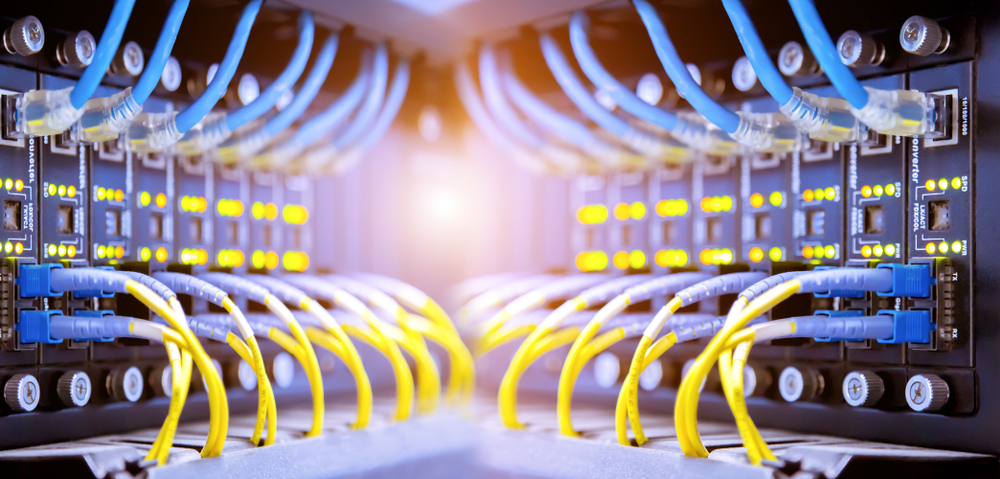Network switches are computer network devices that help manage data flow. These switches have a memory and can identify devices connected to them; they can look up the arriving data packets, find the destination address, and deliver information to the correct device. A network switch in a computer network is essential if you want to connect multiple devices with minimal data collision. In this article, you will learn about network switches, including their types, features, advantages, and challenges; consequently, you will learn the difference between hubs and switches.
Contents
How does a network switch work?
Networking devices communicate using specific standards maintained by the IEEE, or Institute of Electrical and Electronics Engineers. The same standards allow network switches to transfer data with machines, including other switches and routers.
When a device wants to communicate, it sends a data frame to the switch. This frame contains several types of information organized per the protocols, including the message and destination address. When the frame reaches the switch, it reads the destination address. Then it looks up a table called the Look Up Table (LUT) containing the devices connected to the switch. If the destination address in the data frame matches one of the addresses in the LUT, the switch sends the data frame to that address. This address is the MAC address of a device, and it forwards the data frame to all the ports if the destination MAC address is not in its LUT.
Source: Network Switch, Router, and a Hub
Types of Network Switches
There are several types of network switches:
- Unmanaged Switches: These are the most basic switches that only use MAC addresses to communicate with the devices. You cannot configure these switches.
- Manageable Switches: You can configure these switches. In addition, they allow the creation of virtual LANs.
- Intelligent Switches: These switches are more advanced than unmanageable switches but can’t perform as much as manageable switches.
- KVM Switches: You use this switch to connect a keyboard, monitor, and mouse to several servers.
Features of Network Switches
The features of network switches depend on the manufacturer and the type; however, they may have the following capabilities:
- Activate/Deactivate ports on the switch
- Set if you want half duplex (communication in any direction at a time) or full duplex (communication in both directions simultaneously).
- Configure the Quality of Service (QoS) of the ports. This function allows you to set how the switch deals with various packet types. For example, you may prioritize data packets more than voice packets or vice-versa.
- Filter MAC addresses
- Monitor network with SNMP
- Mirror ports
Advantages of Network Switches
Using switches, you can:
- Optimize the available bandwidth: If you use a hub, you must share bandwidth with all the ports. However, each port in a switch has total bandwidth as the switch supports a full duplex.
- Reduce the workload on an individual PC: As you can use switches to connect multiple computers, you can reduce the amount of work given to one. For example, one PC in the network can handle all the graphic processing while another handles CPU-intensive tasks.
- Increase network performance: Switches can optimize port usage; they don’t clog the ports with data constantly, freeing the ports for different transmissions.
- Reduce the packet collision: Hubs have a single collision domain, a single area where data from all the ports collide. This situation increases as the collision domain will handle the entire data flow. In a switch, each port has its collision domain. So each collision domain only takes a part of the total data flow, reducing the collisions.
Source: Collision Domain
Challenges of Network Switches
Though a network switch has several advantages, specific challenges also exist.
- Power Failures: As switches forward electrical signals, high voltage issues can harm the equipment.
- Port Failure: You can easily damage the switch ports while connecting/disconnecting the cables.
- Module Failure: Switches have various modules enabling their functionality. But you can damage it if you are not careful, for example, an unstable power supply or bumping it while moving.
- Port Software Issues: Poor configuration of port parameters can also cause port failures. You might have to configure the parameters manually.
- Compatibility: Network switches may have issues with compatibility because of different protocols, implementation methods, or not dialing default parameters.
- Backplane Failure: Network port switches connect to a shared board called backplane. It can get damaged with high ambient heat or moisture.
- Cable Failure: Because switches use cables to communicate, cable failures are also a challenge of using network switches.
FAQs
Q1. What is the difference between a network switch and a network hub?
Network switches and Hubs are networking devices that help other devices communicate. However, they are different as follows:
- Network switches operate on Layer 2 (data link layer) of the OSI model; network hubs operate on Layer 1 (physical layer) of the OSI model.
- Hubs can not read MAC addresses; Switches can read MAC addresses and send data to the correct device.
- Hubs only have a single collision domain; each switch port has its collision domain.
- Switches can be intelligent, while a hub in a computer network cannot.
Q2. What are the advantages of switch deployment?
A switch deployment can:
- Optimize available bandwidth as you can use full duplex communication
- Reduce packet collision as each port has a collision domain, reducing the collision probability in any individual domain
- Filter MAC addresses to increase security
- Reduce workload for one device as each device can communicate and share different tasks
- Create Virtual Networks for different purposes, each hidden from the other without permission
- Increase the network size by connecting to multiple devices
Q3. To which layer of an OSI model does a switch belong?
A switch belongs to layer 2 of the Open Systems Interconnection or OSI model. This layer is the data link layer that sends and receives data frames. These data frames contain Media Access Controller or MAC addresses; switches can read MAC addresses and send the data frame to the corresponding devices. Switches can’t read the IP addresses; only devices operating on level 3 (network layer) can extract the IP address from the data frame.
Q4. What is the difference between a Switch and a Router?
Switches and Routers are networking devices, but they operate on different levels of the OSI model.
- Switches operate on the data link layer (layer 2), and the routers run on the network layer (layer 3).
- Switches can communicate with data frames; routers communicate with data packets.
- Switches read the MAC address to understand where to forward the data; routers read the IP address for forwarding the data packets.
- Routers are more costly than switches and can handle more complex tasks, like address resolution.













